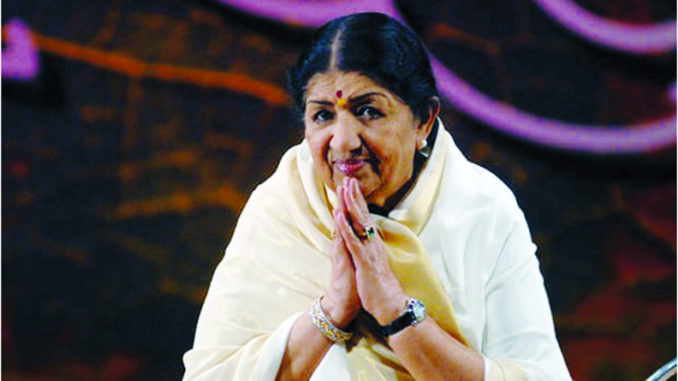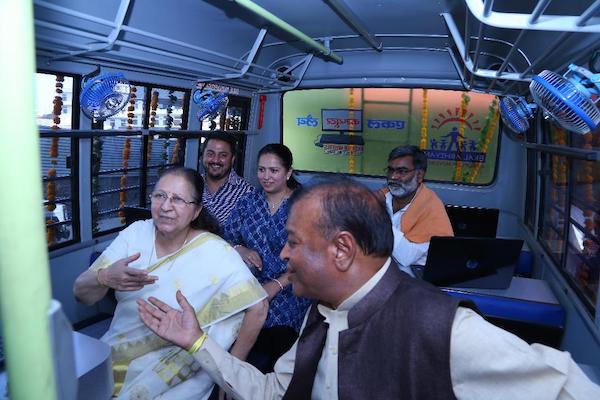
Lata Mangeshkar, “the nightingale of Bollywood”, who has died aged 92 after contracting Covid-19, was a much-loved Indian national and international figure, whose songs provided the backdrop to the lives of millions for seven decades.
Music sung by her was heard constantly across India, in shops, restaurants, taxis or on the radio, and she became known as “Didi”, or sister, because so many people identified with her often emotional songs. And yet she was best known as a playback singer, a vocalist who does not appear onscreen but provides the soundtrack for films in which actors lip sync to her singing.
Her output was extraordinary – she is estimated to have recorded some 25,000 songs, which appeared in more than a 1,000 Hindi films, and she also sang in more than 20 different Indian languages. With an impressive vocal range, covering four octaves, she became massively popular with film directors for her ability to understand the context in which her songs would be used.
Mangeshkar did not just sing, but made sure that her performance matched the storyline and the character, saying that she always read the lyrics and listened to the tune before agreeing to sing.
She first came to national fame in India with the song Aayega Aanewala (meaning “the one who is destined to come will definitely come”), which she recorded in 1949 while still a teenager. A charming and dramatic song, which featured in the film Mahal that year, it was the start of a remarkable career in which she interpreted work by all the major Indian film composers.
For more than three decades she recorded hundreds of songs by the composing duo of Laxmikant-Pyarelal (Laxmikant Shantaram Kudalkar and Pyarelal Ramprasad Sharma), including such hits as Sheesha Ho Ya Dil Ho (from the film Aasha, in 1980). She also worked with SD Burman, and later with his celebrated son the composer RD Burman (who would marry her sister Asha), recording RD Burman songs including Bahon Mein Chale Aao (from the film Anamica, 1973).
Later she collaborated with the most internationally celebrated Bollywood composer, AR Rahman, and sang several of his best known songs including Jiya Jale (from the 1998 romantic thriller Dil Se) and Luka Chuppi (from the 2006 film Rang De Basanti), which she recorded when she was in her mid-70s. Rahman remembered how carefully she would rehearse: “She would sit with her assistant, and would start singing very slowly, with every lyric clear.” She was, he said, “part of a soul, part of a consciousness of India”.
If she had any competition as India’s finest playback singer, it was from her younger sister Asha Bhosle. After all, it was Asha who had Cornershop’s 1997 hit Brimful of Asha written about her, and who had recorded the most number of songs (according to The Guinness Book of World Records Lata was ahead in 1974 but Asha overtook her), and it was Asha who recorded with the experimental Kronos Quartet. Lata insisted there was no sibling rivalry, saying; “we’re very close, we never competed with each other.”
Mangeshkar was born in Indore, in what is now Madhya Pradesh state, the oldest child of Shevanti (later renamed Shuddhamati) and Pandit Deenanath Mangeshkar, a musician and teacher who ran a touring theatre company. Lata never went to school, as she quit on the first day when the teacher refused to allow her to bring her then 10-month-old sister Asha into the classroom.
Much of her childhood was spent singing alongside her father at concerts. He died in 1942, when she was 13, and she then had to support her mother and four siblings. A close family friend, Vinayak Damodar Karnataki, offered her work with his film company Navyug Chitrapat, acting in minor roles. When the company moved to Bombay (now Mumbai) in 1945, she and her family moved with them.
She said she disliked acting “because I was very small and hated putting on makeup and having to laugh and cry in front of the cameras”. But she loved playback singing, and was given her first break with a song in the film Majboor (1948). Then came the film Mahal, which included her hit song, and she rapidly became known as India’s Playback Queen.
Though most celebrated for her film work, she also gave concerts in India and abroad. In 1963, shortly after the Sino-Indian war, she sang the patriotic Hindi song Aye Mere Watan Ke Logon (“Oh people of my country”) to an audience including Jawaharlal Nehru, the prime minister, who is said to have been moved to tears. In 1974 she performed many of her Bollywood hits at the Royal Albert Hall in London, backed by musicians including SD Burman, and was hailed as the first Indian artist to have performed there.
Away from music, her passions included fast cars and cricket – she would insist on taking time off to watch matches. The former Indian captain Virat Kohli was among those who paid tribute to her, as did Imran Khan, another leading cricketer and now Pakistan’s prime minister. He wrote that “the subcontinent has lost one of the truly great voices the world has known” – a reminder that she had a vast following beyond India’s borders.
Mangeshkar may have recorded thousands of emotional love songs, but she never married. Asked about her private life by the Hindustan Times, she said, “there are some things only for the heart to know. Let’s keep it that way.” In 2001 she received India’s highest honour for civilians, the Bharat Ratna. She is survived by her younger siblings Meena, Asha, Usha and Hridaynath, all of whom are singers or composers. Source: The Guardian





Be the first to comment